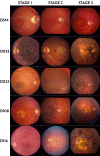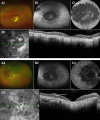Generalized choriocapillaris dystrophy, a distinct phenotype in the spectrum of ABCA4-associated retinopathies
- PMID: 24713488
- PMCID: PMC4005615
- DOI: 10.1167/iovs.13-13391
Generalized choriocapillaris dystrophy, a distinct phenotype in the spectrum of ABCA4-associated retinopathies
Abstract
Purpose: We describe a particular form of autosomal recessive generalized choriocapillaris dystrophy phenotype associated with ABCA4 mutations.
Methods: A cohort of 30 patients with identified ABCA4 mutations and a distinct phenotype was studied. A retrospective review of history, fundus photographs, electroretinography, visual field testing, dark adaptometry, and optical coherence tomography was performed. Genetic analyses were performed by ABCA4 microarray analysis, high resolution melting, and/or next generation sequencing of all protein-coding sequences of the ABCA4 gene.
Results: The earliest recorded manifestation of ABCA4-associated disease was a central bull's eye type of macular dystrophy that progressed to chorioretinal atrophy of the macula with coarse rounded hyperpigmentations and expanding involvement of the periphery. The mean age at first presentation was 10.3 years, the longest follow-up was 61 years. All patients had two ABCA4 mutations identified, confirming the molecular genetic diagnosis of an ABCA4-associated disease. Most patients harbored at least one mutation classified as "severe," the most common of which was the p.N965S variant that had been found previously at a high frequency among patients with ABCA4-associated retinal dystrophies in Denmark.
Conclusions: Generalized choriocapillaris dystrophy is a progressive ABCA4-associated phenotype characterized by early-onset macular dystrophy that disperses and expands to widespread end-stage chorioretinal atrophy with profound visual loss. All cases in this study were confirmed as harboring two ABCA4 mutations. Most of the ABCA4 mutations were classified as "severe" explaining the early onset, panretinal degeneration, and fast progression of the disease.
Keywords: ABCA4; chorioretinal dystrophy; phenotype–genotype.
Figures





Similar articles
-
The Rapid-Onset Chorioretinopathy Phenotype of ABCA4 Disease.Ophthalmology. 2018 Jan;125(1):89-99. doi: 10.1016/j.ophtha.2017.07.019. Epub 2017 Sep 22. Ophthalmology. 2018. PMID: 28947085 Free PMC article.
-
Clinical, Genotypic, and Imaging Characterization of the Spectrum of ABCA4 Retinopathies.Ophthalmol Retina. 2024 May;8(5):509-519. doi: 10.1016/j.oret.2023.10.023. Epub 2023 Nov 3. Ophthalmol Retina. 2024. PMID: 37924945
-
Early-onset stargardt disease: phenotypic and genotypic characteristics.Ophthalmology. 2015 Feb;122(2):335-44. doi: 10.1016/j.ophtha.2014.08.032. Epub 2014 Oct 17. Ophthalmology. 2015. PMID: 25444351
-
[From gene to disease: from the ABCA4 gene to Stargardt disease, cone-rod dystrophy and retinitis pigmentosa].Ned Tijdschr Geneeskd. 2002 Aug 24;146(34):1581-4. Ned Tijdschr Geneeskd. 2002. PMID: 12224481 Review. Dutch.
-
Experimental studies on medical treatments of retinal dystrophies with a particular focus on ABCA4 retinopathies.Klin Oczna. 2016 Aug;118(1):59-65. Klin Oczna. 2016. PMID: 29715411 Review.
Cited by
-
Clinical spectrum, genetic complexity and therapeutic approaches for retinal disease caused by ABCA4 mutations.Prog Retin Eye Res. 2020 Nov;79:100861. doi: 10.1016/j.preteyeres.2020.100861. Epub 2020 Apr 9. Prog Retin Eye Res. 2020. PMID: 32278709 Free PMC article. Review.
-
Recessive multiple epiphyseal dysplasia and Stargardt disease in two sisters.Mol Genet Genomic Med. 2021 Apr;9(4):e1630. doi: 10.1002/mgg3.1630. Epub 2021 Mar 16. Mol Genet Genomic Med. 2021. PMID: 33724725 Free PMC article.
-
Deciphering the genetic architecture and ethnographic distribution of IRD in three ethnic populations by whole genome sequence analysis.PLoS Genet. 2021 Oct 18;17(10):e1009848. doi: 10.1371/journal.pgen.1009848. eCollection 2021 Oct. PLoS Genet. 2021. PMID: 34662339 Free PMC article.
-
Complex inheritance of ABCA4 disease: four mutations in a family with multiple macular phenotypes.Hum Genet. 2016 Jan;135(1):9-19. doi: 10.1007/s00439-015-1605-y. Epub 2015 Nov 2. Hum Genet. 2016. PMID: 26527198 Free PMC article.
-
An Overview of the Genetics of ABCA4 Retinopathies, an Evolving Story.Genes (Basel). 2021 Aug 13;12(8):1241. doi: 10.3390/genes12081241. Genes (Basel). 2021. PMID: 34440414 Free PMC article. Review.
References
-
- Allikmets R, Singh N, Sun H, et al. A photoreceptor cell-specific ATP-binding transporter gene (ABCR) is mutated in recessive Stargardt macular dystrophy. Nat Genet. 1997; 15: 236–246 - PubMed
-
- Cremers FP, van de Pol DJ, van DM, et al. Autosomal recessive retinitis pigmentosa and cone-rod dystrophy caused by splice site mutations in the Stargardt's disease gene ABCR. Hum Mol Genet. 1998; 7: 355–362 - PubMed
-
- Martinez-Mir A, Paloma E, Allikmets R, et al. Retinitis pigmentosa caused by a homozygous mutation in the Stargardt disease gene ABCR. Nat Genet. 1998; 18: 11–12 - PubMed
-
- Fishman GA. Fundus flavimaculatus. A clinical classification. Arch Ophthalmol. 1976; 94: 2061–2067 - PubMed
Publication types
MeSH terms
Substances
Grants and funding
LinkOut - more resources
Full Text Sources
Other Literature Sources
Medical

